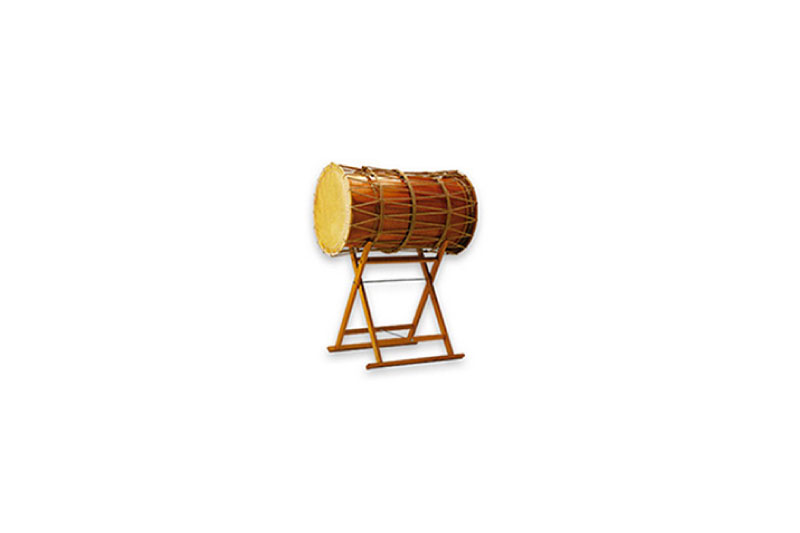
Shakuhachi
The shakuhachi is a five-holed, end-blown flute made of indigenous bamboo with a unique outward-blowing edge. It has a long history, originating in China at the beginning of the Tang dynasty (618-907). The instrument is named for its standard length. One shaku, a traditional Japanese unit of length consisting of ten sun, equals roughly 30 centimeters. The shakuhachi is literally one shaku and eight hachi (or sun) long. This is the standard and most popular length, but flutes can vary from lengths of 1.6 to 3.0 shaku.
The shakuhachi was brought to Japan from China in the late 7th century as part of the original gagaku orchestra.
Evidence also suggests that the shakuhachi was an early meditative tool of esoteric Buddhism. In the Middle Ages, Zen monks would play or listen to the shakuhachi to help achieve enlightenment.The name of this meditation practice, suizen, combined the two words sui (to blow) and Zen (meditation). Literally translated, then, suizen means blowing Zen. Similar to tsukushigoto, this musical form was not meant to entertain an audience; instead, it facilitated inner exploration.
The Fuke sect of the Edo period, open only to samurai, devoted itself to playing the shakuhachi and begging for alms. These men, recognized as a religious sect by the government in 1677, were highly educated and experienced practitioners of Zen. Because the sect traveled throughout the country, the government enlisted some of these men as spies. Thus, the Fuke allowed samurai to combine mendicancy and spiritual goals with spying and, if necessary, criminality. Despite the organization's political origins and occasionally questionable membership, monks reflected a sincere desire for spiritual enlightenment. They would travel from temple to temple exchanging musical pieces with each other. These pieces, called honkyoku (or original pieces, as opposed to the later ensemble pieces called gaikyoku), comprise the solo music of the shakuhachi repertoire. The Fuke sect also saw changes in the instrument itself; the shakuhachi increased in length and became thicker and heavier with a root end. This end could double as a weapon when necessary!
During the Meiji Restoration, one government goal was to abolish the samurai class. After the official ban against the Fuke sect in October of 1871, wandering beggar monks found it practically impossible to earn a living using the shakuhachi as a spiritual instrument. In order to survive, they began to play and teach the their instrument as a musical, rather than a spiritual, tool. From then on, secular playing of the shakuhachi achieved great popularity. New contemporary schools and playing styles developed throughout the country as a result.
Like many other instruments during Shin-Nihon Ongaku, the shakuhachi was redesigned so that it could play Western scales along with Western instruments.
The influence of the Western tempered scale created changes in the shakuhachi's construction. This gave rise to a new version of the flute, which was constructed using Japanese lacquer (urushi) to coat the inside of the instrument. Bone or horn was also added to the mouthpiece. These changes allowed the instrument to play louder and with more stable timbre and pitch.
The shakuhachi has also achieved global use in jazz, fusion, rock, world, new age, and movie score genres. In the 20th century, the instrument's transplantation to the West increased its popularity on a worldwide scale.
Shakuhachi Guided Listening
Tori Kadotsuke Hachigaeshi is a shakuhachi honkyoku piece. A well-known piece with many different versions from different lineages, this one is from the lineage of Okuda-den. Tori means street, Kadotsuke means corner, and Hachigaeshi means returning of the bowl, or begging, so the piece is 'Street Corner Begging'. Begging was a big part of the Fuke sect, so this piece references that element of honkyoku.
Honkyoku pieces are typically quite long, so this recording consists of part one and two of this three part piece. This piece is played on a jinashi shakuhachi, which is a simple piece of bamboo without an added bone mouthpiece or lacquered bore. Notice the windy sound, the squeaks, and the other 'noise' tones that are part of the distinctive shakuhachi jinashi sound.
This piece is a good example of many elements of honkyoku. Sasa buki, or bamboo leaf blowing, describes the shape of each phrase- a long held out phrase that fades into nothing, similar in shape to a leaf of bamboo. The phrases, based on the player's breath, are unmetered. You will also notice the essential Japanese aesthetic of ma (void, emptiness) in between the phrases. You will also hear some shakuhachi playing techniques: komi buki is a diaphragmatic technique of pulsing the breath, and nayashi slides up from a lower pitch microtonally to a higher note.
The shakuhachi can produce notes with a range of three octaves and plays a pentatonic scale. Movement of the head to different positions and specific fingering, however, achieves the pitches between the primary notes of the scale. The player can therefore play many microtonal pitches and slides in addition to the primary notes.
What to Listen for:
- Listen for the unusual tones that make up the jinashi shakuhachi sound: the squeaks, the windy, breathy tones, and the pure tones that are part of the timbre of the instrument.
- Experience the slow, umetered, meditative element of the piece, and the moments of ma, or emptiness, between the phrases.
- Notice how different phrases end with a short, cropped articulation, a lowering of the pitch, or a sustain into silence.
Composer: Anonymous
-
"Tori Kadotsuke"
| Listening Guide | |
|
Tori Kadotsuke Hachigaeshi
|
Composer: Anonymous
-
"Tori Kadotsuke" [ 00:00-00:03 ]00:03
Notice the komi buki sound of pulsation in the first melodic phrase.
Composer: Anonymous
-
"Tori Kadotsuke" [ 00:04-00:18 ]00:15
Many times the same pitch is played with different fingering to create a different timbre, as you can hear in these first two phrases.
Composer: Anonymous
-
"Tori Kadotsuke" [ 00:19-00:28 ]00:09
This phrase begins with a big, slow, nayashi.
Composer: Anonymous
-
"Tori Kadotsuke" [ 00:29-00:54 ]00:24
These articulations of a note are a common characteristic of honkyoku melodic lines.
Composer: Anonymous
-
"Tori Kadotsuke" [ 00:55-01:14 ]00:19
These articulations of a note are a common characteristic of honkyoku melodic lines.
Composer: Anonymous
-
"Tori Kadotsuke" [ 01:15-01:45 ]00:30
Here is another nayashi.
Composer: Anonymous
-
"Tori Kadotsuke" [ 01:46-02:02 ]00:16
Notice the wavering sound of the pitch in this phrase- the player moves the head diagonally up and down to make the pitch higher and lower.
Composer: Anonymous
-
"Tori Kadotsuke" [ 02:03-02:21 ]00:18
Listen as this line fades slowly into silence- sasa buki
Composer: Anonymous
-
"Tori Kadotsuke" [ 02:22-02:49 ]00:27
This phrase begins in the lower octave and then jumps to the higher one.
Composer: Anonymous
-
"Tori Kadotsuke" [ 02:49-03:23 ]00:35
Listen as the melody goes higher and higher in pitch in these next phrases.
Composer: Anonymous
-
"Tori Kadotsuke" [ 03:24-03:36 ]00:11
Listen for the articulations of the note, and how they begin slowly and then speed up as they develop.
Composer: Anonymous
-
"Tori Kadotsuke" [ 03:37-03:55 ]00:17
Listen for the komi buki
Composer: Anonymous
-
"Tori Kadotsuke" [ 03:55-04:09 ]00:14
In this final phrase, notice the long, sustained quality of the notes and the short cut off at the end of the phrase.
Taiko
The word taiko, or big drum, represents all of the different types of Japanese drums used in taiko music. Its first ensembles formed after World War II, setting the genre apart from its ancient Japanese predecessors. Taiko ensembles use a wide range of instruments in addition to drums, including aerophones, idiophones, and chordophones. Kumi-daiko was invented in the 1950s by one man: Daihachi Oguchi, a jazz drummer.
Taiko drumming movements, which look very similar to the martial arts, are as important to a performance as the music itself. The genre's groups gained worldwide exposure and recognition at the 1964 Tokyo Olympics and the Osaka World Exposition of 1970. Afterward, many amateur taiko groups formed in Japan and across the globe. Today in the U.S., many colleges and communities throughout have their own taiko groups.
Taiko drum-playing poses significant physical, mental, and artistic challenges. Considerable strength and stamina are required to strike many large drums at speed for extended periods. Therefore, technique and choreography demand top physical condition. Choreographed movements help coordinate drum strokes between players and are highly entertaining for the audience. Mental focus and group coordination are essential elements of a taiko drum ensemble.
The isolated island of Sado produced two of the primary taiko drumming ensembles, Ondekoza and Kodô. Ondekoza, the 1969 founder of modern taiko, has spawned and influenced many subsequent groups. Using the drum as a spiritual tool, its founding precepts include: mental, physical, and spiritual discipline; group harmony; and the principle of Sogakuron, which is based on the idea that "running and drumming are one and a reflection of the drama and energy of life."
A few years after Ondekoza materialized, a several members formed the new group Kodô. The group has performed close to 4,000 times in Japan and abroad since its Berlin debut in 1981. Many other taiko groups (e.g., Oedo Sukeroku Taiko, Osuwa Daiko, and the San Francisco Taiko Dojo) tour worldwide. The experience of a live taiko performance, with its deep, resonant tones and elaborate choreography, is a truly special multi-sensory experience.










 Taiko
Taiko Katsugi Daiko
Katsugi Daiko Nagado Daiko
Nagado Daiko Ohjime Daiko
Ohjime Daiko Okedo Daiko
Okedo Daiko Okehime Daiko
Okehime Daiko Tsukeshime Taiko
Tsukeshime Taiko Uchiwa Taiko
Uchiwa Taiko

